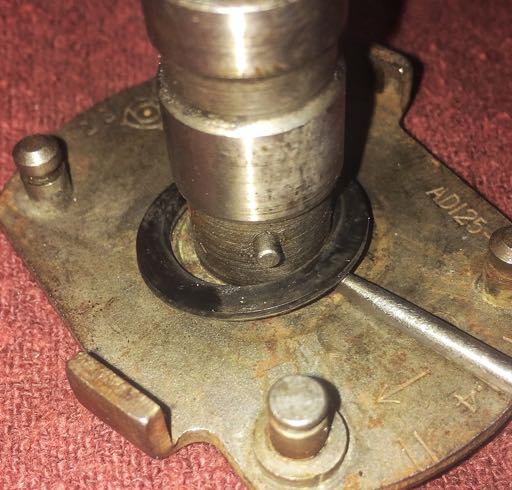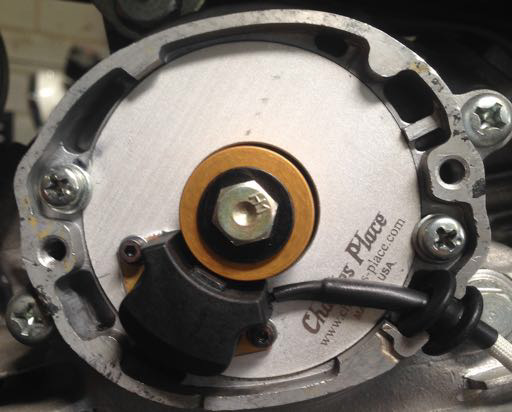Before Installing:
1. Make sure you have a good running engine to begin with! You don't want to end up chasing your tail trying to troubleshoot a problem that has nothing to do with the ignition.
2. Setting the timing requires patience and an understanding that the system is precise and requires some trial and error to get right. Once set correctly, it will probably never have to be readjusted. That's the beauty of an electronic ignition!
3. Make sure your battery is fully charged prior to installation.
4. Get a good quality test light. Do NOT attempt to set the timing with a dynamic timing light, this will damage the triggers and void the warranty.
5. It is recommended to replace spark plugs and caps.
6. It is recommended to upgrade the charging system with a Charlie's Place regulator rectifier. The minimum operating voltage for the 6v ignition is 2.5v. If your charging system is chronically weak and drops below this voltage, the ignition will NOT work. We recommend you check your charge prior to installing the new ignition.
7. ’74-’78 XL100 - This ignition will only work with a stock genuine Honda ignition coil.
8. If after reviewing the installation instructions and videos where applicable you feel this job would be better suited to a professional mechanic please contact a local shop about doing the installation prior to purchase.
Installation Instructions:
1. Power must be off.
2. Disconnect negative terminal from battery.
3. Remove existing points and condensers.
4. Carefully remove outer rotor from advance unit. Check springs on advancer to make sure they are operating properly. Lubricate or adjust if necessary.
5. Install new rotor. Be sure to remove any shim washers at the base of the advancer shaft. Also check to see if there is a cast in pin also near the base of the shaft. This will need to be ground off to install the new rotor.
6. When installing rotor, you must first locate your compression stroke. This can be done by removing the intake valve cover and watching the movement of the intake valve. Shortly after the intake valve closes, the piston will be rising inside of the cylinder to create the compression stroke. Rotate your motor to the “T” position at this point. Install the rotor on the advancer so that the magnets are at approximately 9 o’clock off the end of the camshaft. If you are able to set your timing successfully but cannot get the bike to start, or if you hear a loud backfire when trying to start it, simply flip the rotor 180 degrees on the advancer and reset the timing.
7. Please note that not all advancers are of even height therefore it may be necessary to shim the end of the camshaft or advance mechanism so that the retaining washer on the end of the camshaft does not bind against the rotor. This must be checked carefully. Washers are provided for this purpose; it may be necessary for better fit to use other washers as well. Also note on some models the retaining washer has a smaller O.D. than the I.D. of the new rotor. Therefore, a larger retaining washer is provided with the unit.
8. Install new plate with pickup already mounted. DO NOT REMOVE pickup from plate. The pick up should be on the Left side of the plate. It may be necessary to remove the washer from the Left hand securing screw in order to make sure the plate is secure without problems.

9. Plug unit in as follows: female Blue coupler to male Blue from coil; Black female connector from unit plugs into Black male connector from coil. Black male coupler from unit plugs into Black wire at harness (previously connected to Black male wire from Coil).
10. Reconnect negative terminal at battery.
11. Do NOT attempt to set your timing using a dynamic timing light. It will damage the triggers if the ignition plate is loose/loosened while the bike is running. This will cause a ground failure that will short the capacitors inside the triggers.
12. Using a 12 volt test light, hook up one end to ground (on the engine) and run the other end of the test light in series with the blue or yellow wire that comes from the unit (where it plugs into the coil). Rotate the crankshaft rotor to check the timing. The light will stay on until approximately 40 degrees before the “F” mark reaches the pointer. This is the point at which you should set your timing. The light should come on exactly at the "F" mark. If adjustment is necessary, rotate the entire plate to set the timing. Note: Do not touch the pick up fastening screws or attempt to adjust the position of the pick up on the plate. Rotate the entire plate to adjust.
Installation support available by calling Charlie's Place (818) 550-0600 or emailing
